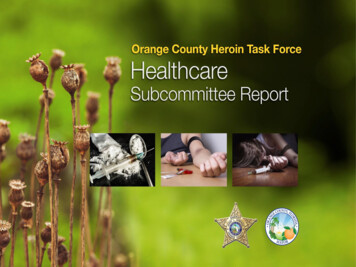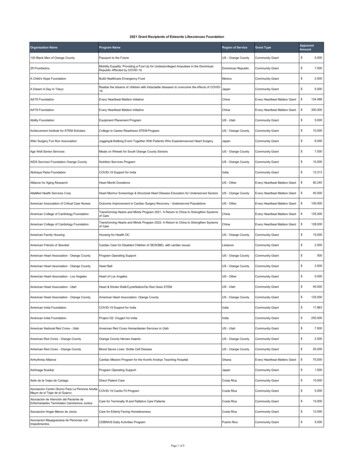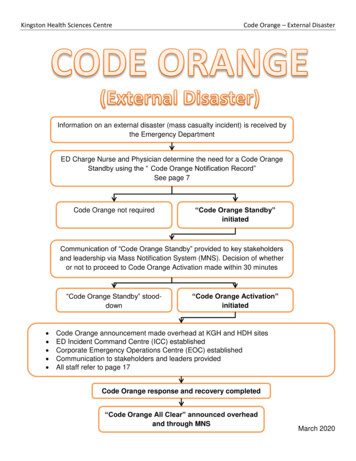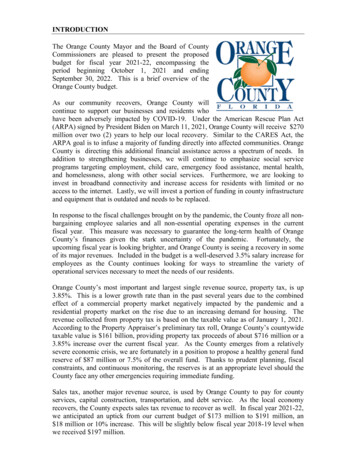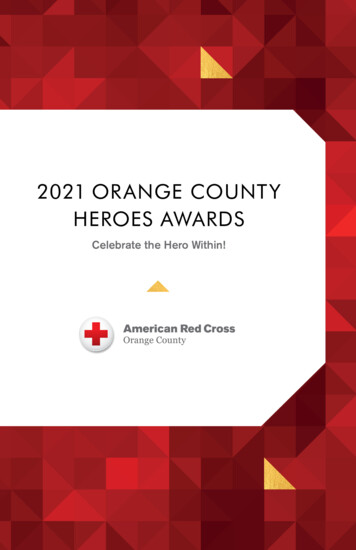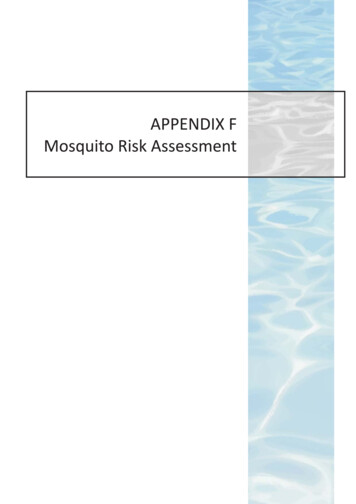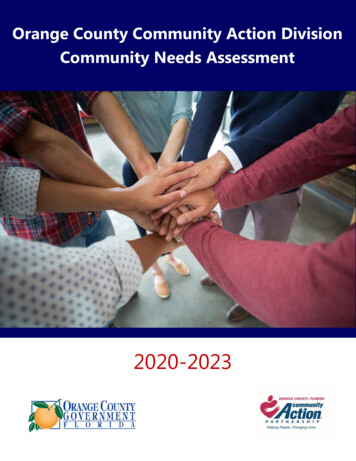
Transcription
communityCHOC CHILDREN’S HOSPITAL1201 W. La Veta Ave.Orange, CA 92868714.997.3000CHOC CHILDREN’S AT MISSION HOSPITAL27700 Medical Center Rd.Mission Viejo, CA 92691949.347.8400Walk the corridors of CHOC Children’s and you will see, first and foremost, a community.This community is broad and wide, comprised of not only doctors, nurses, therapists, and associates,but also of families, donors, volunteers, neighbors and corporations—all dedicated to a commongoal: the health and well-being of children. Each day, this diverse CHOC community offers itsexpertise, empathy, and experience to make a meaningful difference in the lives of children andfamilies. By keeping children healthy, the CHOC community keeps childhood healthy too. In thepages of this year’s Annual Report, you will meet members of this compassionate community whotogether fuel the engine that drives CHOC Children’s. Long Live Childhood.CHOC.ORGAffiliated with 2018 Children’s Hospital of Orange County. All rights reserved.2O18 A N N UA LR E PORT
P8P12P18P26P14community
First, in April 2018, CHOC Children’s opened the region’s first pediatric mental health inpatient center, markingthe culmination of a tremendous effort to provide vital mental health services for children, adolescents and youngadults in our community.Second, CHOC Children’s physicians, staff and parents teamed up to bring a promising drug (Brineura) to ourhospital to fight Batten disease, a rare disease of the nervous system. Today, CHOC Children’s is the largestcenter in the United States, and the second largest center in the world, treating Batten disease with thiscommunitybreakthrough drug.Lastly, in April 2018, CHOC Children’s announced plans to open the Thompson Autism Center early next year,made possible by a visionary 10 million founding gift from the William and Nancy Thompson Family Foundation.The Thompson Autism Center will be devoted to evaluating children as early as possible to promote betteroutcomes and establishing a long-term support system for children with complex care needs.These three milestone events have one theme in common: The power of community. None could have happenedwithout a unified effort that combines not only financial resources from generous donors big and small, but alsothe knowledge and experience of concerned hospital physicians, associates, donors and community memberswho saw a great need and came together to meet the challenge.Someone who truly understood the importance of community to serve the collective vision of CHOC Children’swas Dr. Nick Anas, who passed away unexpectedly on April 3, 2018. Dr. Anas held a variety of posts, includingdirector of CHOC Children’s Pediatric Intensive Care Unit from 1991-2018 and Physician-in-Chief since 2009.Dr. Anas embodied the true spirit of CHOC by being a tremendous physician, supportive colleague, brilliantresearcher and phenomenal educator. And no matter how hectic his schedule, Dr. Anas made time for us all. Heknew how to break down barriers and find common ground, always staying focused on doing what was best forour patients. He is deeply missed.Another great visionary and unifier was L. Kenneth Heuler, DDS, who passed away May 30, 2018. Dr. Heulerserved on the CHOC Children’s Board of Directors for 30 years, including many years as Board chairman, beforeretiring from his CHOC involvement at age 93. His dedication is an inspiration to us all.I also want to mention and give thanks to our Board Chair David Dukes, who will be terming off this year. David’sgreatest strength is his expertise in collaboration, bringing together a very motivated Board that was able to turnvision into reality. Our Foundation Board leadership must also be commended for the dynamic work they aredoing to raise funds to support our mission and vision.Dear Friends, It never ceases to amaze me what we asan organization can accomplish through determination,passion and a shared sense of purpose. This past year,three remarkable events illustrate my point.Working together, we can create a world-class health care community that will “preserve the magic of childhood.”All of us want our children to have a happy and healthy childhood protected against illness and trauma. This comingfall, look for a new marketing campaign designed to highlight this message and support CHOC Children’songoing mission to nurture, advance and protect the health and well-being of children.It will take all of us to reach this goal. Thank you for your continued support,Kimberly Chavalas CripePresident and Chief Executive OfficerCHOC Children’s62018 CHOC CHILDREN’S ANNUAL REPORT7
communityGround-Breaking Mental Health Inpatient Center Opens Its DoorsThe April 2018 opening of the 18-bed CHOC Children’s Mental Health Inpatient Center is a historicmilestone for the region, representing the culmination of years of vision and hard work.The only facility in Orange County to treat patients younger than 12 and the only facility in California tooffer all private rooms, the Center fulfills CHOC Children’s commitment to ensure Orange County youthreceive the mental health care services they need in a safe and nurturing environment.“It feels very different from a traditional psychiatric unit,” notes Dani Milliken, RN, clinical director of theCenter. “We tried to create a place of healing rather than a sterile, institutional environment.“For example, the Center has a bright, over 3,000-square-feet outdoor area enclosed with a beautiful wall,where kids can enjoy sun and fresh air, and have some space,” Dani says. Other unique features include twosensory rooms – one sensory-rich and the other low-stimulation—to help children learn to manage strongemotions and calm themselves.In contrast to traditional inpatient psychiatric units, which often restrict visiting hours, parents have accessto their children 24/7. Programming runs from 7:30 a.m. to 9 p.m., and children eat all of their meals in amain dining room donated by the J. Willard and Alice S. Marriott Foundation (see related story). The diningroom also serves as a communal space for meetings and therapeutic sessions.THE DREAM TEAM“While the Center is state-of-the-art, I believe our positive outcomes can be attributed directly to whatI refer to as ‘The Dream Team,’ a staff who includes nurses, mental health assistants, child life specialists,teachers, social workers, psychologists, psychiatrists and other medical professionals,” Dani says. “We“ I was excited that CHOC Children’s was creatingthis Center for all the right reasons.” — Dani Millikenhave created a positive culture that feels like a big family.”Patients treated at the Center range from ages 3 to 17. “The 3- and 4-year-olds often are living hard liveswith a lot of trauma,” Dani explains. “With children as young as 5, we start to see major depression andsuicide attempts.”Other conditions include attention deficit disorder, oppositional defiant disorder, intermittent explosivedisorder, bipolar disorder, and young people who are on the autism spectrum, self-injurious, suffering fromsuicidal thoughts and anxiety, or who have experienced their first psychotic break.Dani, a veteran psychiatric nurse with an extensive background in the design and operation of pediatricmental health units, notes that the Inpatient Mental Health Center would not exist without major supportfrom the community. (Lead gifts were provided by children’s advocate Sandy Segerstrom Daniels and FromMy Heart/Sharon D. Lund Foundation.)It was this strong support that inspired Dani to leave Ohio in June 2017 to help launch the unit.“Pediatric mental health units do not exist without outside community support,” Dani points out. “TheyUnder the leadership of Dr. Wayne Nguyen, Dani Milliken and Lisa Schneider, CHOC’s mental health teamis dedicated to fostering an environment of healing and positivity for children and teens in crises.have to be financially sustainable, which can be difficult as there is decreased insurance reimbursement. Iwas excited that CHOC Children’s was creating this Center for all the right reasons. The community stood upand has given a lot of money. The result is a Center of excellence for children with mental health needs.”CHOC launched acampaign encouraging parents to addressmental health thesame way we addressphysical health.82018 CHOC CHILDREN’S ANNUAL REPORT9
communityDining Room Donation Embodies Marriott’s History, Core ValuesChris Harrison has a very special place in his heart for pediatric healthcare. It could stem from the facthe was born prematurely and needed serious medical attention to thrive.Or the fact his great grandparents, who founded the Marriott Corporation, were strong advocates forprotecting and giving opportunities to the youth of the world.In September 2017, Chris, who serves as the general manager of the newly opened 271-room MarriottIrvine Spectrum Hotel, and is a husband and the father of three young children, put his convictions into“I immediately asked, ‘How can I help’ becausethe cause is very near and dear to my heart.” — Chris Harrisonaction—making time in his extremely hectic schedule to join the CHOC Foundation Board so he, too,could make a difference.“During a Board meeting, one of the members mentioned the need to finish out the capital campaignfor the CHOC Inpatient Mental Health Center, and my ears perked up,” Chris recalls. “I immediately asked,‘How can I help’ because the cause is very near and dear to my heart.”He notes that attracting large donors for mental health facilities is daunting because the condition is stillstigmatized and remains underfunded compared to other pediatric diseases.Chris, who calls himself a “hotel kid” growing up at Marriott properties across the globe, explains that hisfamily has been strong advocates for better mental health care for decades. “Both sides of my family haveexperienced struggles with mental illness,” Chris says. “It is a condition that is not talked about enough.”Learning of CHOC Children’s efforts to bring inpatient mental health services to Orange County “was anemotional, legacy moment for me,” Chris notes. “I’ve seen the toll depression and bipolar disease takes,and the lack of treatment options and facilities. I knew there absolutely had to be a better way.“CHOC Children’s presents a solution that is innovative, unique on the West Coast, and brings a holisticapproach to treating pediatric mental illness,” he says.Marriott’s philanthropic arm, the J. Willard and Alice S. Marriott Foundation, is “dedicated to furtheringeducation, healthcare and the perpetuation of young people.” Says Chris, “The Foundation is named aftermy great grandparents who founded the company, and its mission is closely aligned with CHOC Children’smission. It was a natural for the Foundation to invest in the inpatient mental health center.”Chris notes that the Marriott Corporation actually started off as a restaurant chain. In 1927, his greatgrandparents opened up a root beer stand in Washington, D.C. The couple later expanded into a chainof Hot Shoppes restaurants.“So naturally, funding the CHOC Inpatient Mental Health Center’s dining room truly honors our familyhistory and heritage while enhancing the lives of young people struggling with mental illness (see previousstory),” Chris says. “The Foundation funded the Marriott Family Dining Room, donating 500,000 to providea place where patients can break bread, share moments and heal.”Chris adds, “To be able to participate in this effort is a huge blessing. We are proud to be a part of it.”CHOC’s mental healthefforts resonated withChris Harrison and theMarriott Foundation’scom mitment to empowerpositive change amongyoung people.102018 CHOC CHILDREN’S ANNUAL REPORT11
Determination, Grit And Vision Place CHOC Children’s OnForefront Of Clinical Research For Batten DiseaseOne of a physician’s most difficult responsibilities is counseling a family whose child has been diagnosedcommunitywith a rare condition where there are no treatment alternatives available.Until recently, one such rare condition was CLN2 disease, also known as late infantile Batten disease—acondition that typically begins with language delays and seizures before age 3, and rapidly progresses todementia, blindness, loss of the ability to walk and talk, and death in childhood.Raymond Wang, MD, Director of the Multidisciplinary Lysosomal Storage Disorder Program at CHOCChildren’s, found himself in this devastating situation with Bekah and Daniel Bowman after a sophisticatedgenetic test revealed their son, Titus, had Batten disease (please see accompanying story).“I immediately got on the internet to search for any clinical trial to treat CLN2,” Dr. Wang recalls. “I foundone for an experimental drug called Brineura, which replaces an essential enzyme not produced in thisdisease. However, the clinical trial was full, and so we were essentially locked out.”And thus began a three-year effort to bring the drug to CHOC Children’s. Dr. Wang took it into his ownhands to complete and submit the complex paperwork, and worked closely with his team to make arrangements to treat these children.“You have to have an agreement between the company and the hospital, you need a protocol and thehospital has to have its IRB (Institutional Review Board) approve the study,” Dr. Wang notes. “It took a reallylong time to get the approval, but we got it.”While the effort was too late for Titus, it came in time for his brother, Ely, who was able to receive treatment inColumbus, Ohio before returning to CHOC Children’s March 25, 2017, once the clinical trial was approved here.While Brineura, which received FDA approval April 27, 2017, does not cure the disease, it does slow downits progress. At CHOC Children’s, Dr. Wang works closely with neurosurgeon Joffre Olaya, MD, and the nurses“ Our goal is to provide hope, whether in the form of a clinicaltrial or treatment, or if there is no treatment then lab researchto develop a treatment.” — Raymond Wang, MDof the 5th floor Neuroscience Institute to administer the medicine. Dr. Olaya implants a reservoir under thepatient’s scalp, which allows the medicine to be infused directly into the brain.The infusion lasts four hours, followed by an hour of observation. Melissa L. Rodriguez, RN, BSN, CPN, isone of the first nurses trained to deliver this medication at CHOC Children’s. As of June, nine patients werereceiving Brineura at CHOC Children’s.“It is amazing to be part of a new medicine that can help slow the progression of Batten disease,” Melissasays. “The children and their families are with us for about eight hours total every other Friday, so they getto know us and are very comfortable. And we know their routines and what they need.”Dr. Wang notes that CHOC Children’s is now the largest center in the United States, and the second largestcenter in the world treating Batten disease with Brineura. “Our goal is to provide hope, whether in the formof a clinical trial or treatment, or if there is no treatment then lab research to develop a treatment,” Dr. Wangsays. “We fought so hard to bring this treatment to families, and it is rewarding to see how far we have come.”“ We fought so hard to bring this treatment to families, andit is rewarding to see how far we have come.” — Raymond Wang, MD122018 CHOC CHILDREN’S ANNUAL REPORT13
Celebrating Ely – A Homecoming StoryHomecoming.It is the word that best describes March 24, 2017—the day Bekah and Danny Bowman brought their son Ely,communitythen 3, to CHOC Children’s to receive a new, novel drug to treat Batten disease (please see previous story).Homecoming because during the previous six months, the family had to fly every 10 days to Columbus,Ohio, for Ely’s infusion of Brineura.Homecoming because Ely’s older brother, Titus, who had succumbed to the same rare genetic disease atage 6, had been a patient at CHOC.Homecoming because after a 2-1/2 year effort, CHOC Children’s became a clinical site for Brineura. Elycould finally be treated at “home.”“Walking into the CHOC neuro floor for that first infusion with Ely, my heart was heavy with memories,”recalls Bekah Bowman. “The last time we were there, Titus was very sick and we couldn’t do a lot for him.Brineura was not available.“Yet when we rounded the corner, the whole team on the neuro floor was there, in a semi circle, waiting togreet us with the biggest smiles and cheers,” Bekah says. “Our hearts went from weighted grief to gratitude.It was incredible and redemptive.”Since that time, Ely has undergone 46 total infusions (as of June 30, 2018), which involves sitting still for fourhours every other Friday as the medicine is infused directly into his brain.Batten disease is a recessive disorder, which means that both Bekah and Danny carry the defective gene.Titus and Ely each had a 25 percent chance of inheriting both copies.The condition typically begins with language delays and seizures before age 3, and rapidly progresses toblindness, loss of the ability to walk and talk, and death in childhood. “The boys were diagnosed with Battendisease 2-1/2 months apart,” says Bekah. “We were a family who needed hope.”Bekah notes that as Ely celebrated his 5th birthday July 6 – complete with a new goldendoodle puppynamed BoBo—he is in “a much better place” than Titus was at this same age. He can walk independently,eat by mouth completely, can speak some favorite words including “whale” and his seizures are under control.“At this point Titus was in a wheelchair, not talking, could not eat by mouth and had over 100 seizures a day.”Ely’s biggest hurdle is progressive vision loss. “At this point, there are aspects of the disease that are nottreatable,” says Bekah.With support from their church, the boys’ school, compassionate friends and strangers, the Bowmansmanage to find joy amidst the challenges. In addition, CHOC Children’s has become family—a communityof healthcare professionals who welcome Ely by name and make his stay as comfortable as possible.“We are so thankful,” says Bekah, “and even though we don’t know how our story will end, we feel part ofthe CHOC team as we pave the way for future children with Batten disease.”“ Our hearts went from weighted grief to gratitude.It was incredible and redemptive.” — Bekah Bowman142018 CHOC CHILDREN’S ANNUAL REPORTInnovative treatmentclose to home has giventhe Bowmans opportunities for normalcy, funand a furry addition tothe family.15
CHOC Children’s At Mission Celebrates 25th AnniversaryIn 1993, CHOC Children’s made the commitment to address a healthcare gap in south Orange County“ Even as CHOC Children’s at Mission celebrates 25 years ofaccomplishments, we are continually looking forward.” — Kim Cripeby opening an innovative, state-of-the art, separately licensed, 48-bed pediatric facility on the 5th floorof Mission Hospital.Twenty-five years later, the program has expanded dramatically, earning a nationwide reputation for itsunique model of care. This achievement can be attributed to a dedicated staff and physicians, gratefulpatients and families, and tremendous community support.The numbers speak for themselves. Since 1993, more than 50,000 pediatric patients have been treated,with the physician medical staff increasing from 49 to 476. The facility now has 22 neonatal intensive carebeds, 8 pediatric intensive care beds and 24 medical/surgical beds, which include 4 beds dedicated toepilepsy monitoring.communityA sleep center, accredited by the American Academy of Sleep Medicine, offers three private rooms toconduct sleep studies to diagnose medical issues related to sleep. Through a partnership with RonaldMcDonald House Charities, CHOC Mission features the Ronald McDonald Family Room and 2 SleepRooms to provide comfort and care to parents of critically ill children.Families in south Orange County have access to pediatric expertise in the Emergency Department aswell as a Level II Pediatric Trauma Center, with 3,600 trauma patients receiving treatment since 1994.Without a doubt, it has been a unique and highly valued partnership with Mission Hospital.The 25-year success of CHOC Children’s at Mission can be linked to two key factors: highly specializedstaff and physicians, and a program that is flexible enough to rapidly implement new programs such asepilepsy monitoring, telemedicine and the sleep center.The hospital has a separate medical staff from CHOC Children’s Orange, and several doctors have beenat the facility from the beginning. The medical staff has continually scored in the 99th percentile in termsof physician satisfaction. In addition, many staff members, including nurses and child life specialists, arelong-time employees who truly feel like family.More than 200 celebrants came together July 26 at the Arroyo Trabuco Golf Club in Mission Viejo tomark the 25th anniversary milestone. Paul S. Lubinsky, MD, a pediatric critical care specialist who openedthe CHOC Mission pediatric intensive care unit, and was the first CHOC at Mission’s chief of staff, sharedhis memories in the featured speech.Since opening its doors on July 15, 1993, CHOC Mission has become a valuedhealth care resource for children and families in south Orange County and beyond.162018 CHOC CHILDREN’S ANNUAL REPORT17
CHOC1 Helicopter Takes Flight, Elevating Patient TransportOn April 1, 2018, the “CHOC1” helicopter landed for the first time on the South Towerroof, marking the launch of a new era for Emergency Transport Services at CHOC Children’s.“Our helicopter is a game changer,” says Tari J. Dedick, BS, RCP, NPS, manager ofEmergency Transport Services. “On a typical afternoon, when minutes really matter, wecan fly down to CHOC Children’s at Mission Hospital in seven minutes as opposed todriving for one hour in bumper-to-bumper traffic on the crowded freeways.”CHOC1 flies all over the Southland, from South Orange County to the Inland Empire—even as far north as Bakersfield, transporting critically ill patients back to CHOC.According to service partner, Mercy Air, CHOC1 is the only helicopter in Southern Californiabased out of a hospital, with four pilots and mechanics housed on site at CHOC Children’s,communitygiving the transport team the ability to jump into action immediately.The helicopter is specially configured with high-tech equipment including neonatalisolettes and smart IV pumps that are loaded through the back of the aircraft and securedinto a confined space.One device in the helicopter is designed to cool critically ill newborn infants. “To helpreduce chances of neurological impairment in these sick newborn babies, cooling needsto be initiated within six hours of birth, or even earlier for better outcomes,” Tari says.“If we pick up a critically ill baby in the Inland Empire, we can begin cooling immediatelyat the bedside and continue the therapy in the helicopter on the way back to CHOC,The addition of a helicopter increases capacity for CHOC’stransport team, which is already one of the busiest in the nation.saving precious time.“Safety is our number one priority,” Tari adds. Mercy Air maintains its Commission onAccreditation of Medical Transport Systems (CAMTS) accreditation, which has stringentrequirements about staff training, medical equipment and even what the CHOC Children’stransport team wears, including flight suits and helmets.Weight and balance restrictions are closely tracked by the pilot. Tari admits it is oftena “tight squeeze” in the helicopter, with every person and each device weighed priorto flight to determine precise weight and balance.In its first three months alone, “CHOC1” made more than 60 flights—dramaticallyimpacting the lives of critically ill children throughout Southern California.“Looking to the future, we anticipate that eventually, we will be able to transport traumapatients from all over the Southland so they can be treated at our Level II trauma center,the only dedicated children’s trauma center in Orange County,” Tari says. “Without a doubt,CHOC1 is widening our outreach while bringing the Southern California community closer.”Remembering Dr. Nick Anas, June 14, 1950 – April 3, 2018One of the Emergency Transport Services’ most ardent supporters was Nick Anas, MD, senior vicepresident and physician-in-chief at CHOC Children’s. Dr. Anas was a nationally recognized expert boardcertified in both critical care and pediatric pulmonary medicine.“Most members of our CHOC transport team worked side-by-side with Dr. Anas over the past severalyears, and his loss has been felt deeply,” Tari says. “He knew the helicopter was coming to CHOC and“Our new helicopter is a game changer.” — Tari J. Dedickwas excited about the potential opportunities it would bring to the organization.”A memorial inscription bearing his name has been placed on the helicopter.“Every time CHOC1 flies, we will be honoring Dr. Anas,” Tari says.“He leaves an inspiring legacy.”182018 CHOC CHILDREN’S ANNUAL REPORT19
Creating A Survivorship Community For Young AdultsAdolescents and young adults with cancer (AYAs) travel a different road than do younger children andmature adults. These AYAs are at an age where they feel invincible—they are young, healthy and on theverge of independence. Yet a diagnosis of cancer abruptly puts their plans and dreams on hold. They arecaught in-between two worlds – pediatric cancer treatment, with its focus on children, and adult cancerprograms where they can feel lost and isolated.“Research has shown that overall long-term survival rates are exponentially better for AYAs treated at apediatric facility that has cancer clinical trials and program activities geared to their unique needs,” notesSharon Bergeron, RN, BSN, CPON, Research Educator, Hyundai Cancer Institute at CHOC Children’s.“In response to this research, we have created a community at CHOC Children’s through our AYA programto support these young patients,” Sharon says. “It makes no sense to get them through a cancer diagnosisif they have nothing to look forward to, no future. We want to give them that future.”Sharon notes that the CHOC Children’s AYA program is carefully designed to give patients life skills whileproviding emotional support both during treatment and as survivors.With this established AYA community, CHOC has given AYA patients the ability to have a strong voice increating a program that focuses on their unique situation.“We are investing in their survivorship,” she says. “We work closely with CHOC Children’s long-term follow-upmedical clinic ACTS: After the Cancer Treatment Survivorship Program to help these young people preparecommunityfor the future.”This past spring, the AYA program held its first job fair, attracting companies from throughout the OrangeCounty area, as well as organizations that help students with learning differences succeed in college.Leadership is a key focus of the CHOC Children’s AYA program. The program has a patient leadership groupcomposed of patients and siblings that meet every other month with a multidisciplinary team of child lifespecialists and healthcare professionals who plan activities and give their input on how to address a varietyof situations that are unique to these patients.Patient leaders have also held two AYA spring retreats that have focused on both leadership/mentorshipA national model, CHOC’s AYA program offers a host of activities designed toencourage bonding and increase self-esteem among a unique patient population.skills and wellness and survivorship to enhance the learning experience for the AYA patient and promotea mindset towards the future. This program has extended to a pilot yoga program, along with establishedactivities in creative writing, art and music therapy.The AYA program has recently gained nationwide attention. A poster that highlighted the mentor retreatearned 1st place honors in December 2017 at the 2nd Global AYA Cancer Congress in Atlanta, Georgia.And five CHOC AYA cancer patients were featured in the 2018 SCAPHON Nursing Conference KeynoteAddress moderated by Kara Noskoff that also highlighted our AYA program and understanding theAYA patient experience.“None of this would be possible without the help of an incredibly generous community of concernedindividuals who see the potential in these amazing patients,” Sharon says. “This includes the generousdonation of the Hunsakers, for whom are program is now named: Richard C. and Virginia A. HunsakerAdolescent and Young Adult Oncology Child Life Program.” (Please see accompanying story.)Sharon says, “These kids are fighters. And our goal is to empower them to succeed, lead and thrive.”20“ Our goal is to empower them to succeed,lead and thrive.” — Sharon Bergeron, RN, BSN, CPON2018 CHOC CHILDREN’S ANNUAL REPORT21
Donation Recognizes Unique Challenges Of Teen Oncology PatientsOur junior high, high school and college memories shape who we become. From football games and dances,to dating and learning to drive, to concerts and college applications, the adolescent and the teen years aretypically filled with a combination of promise and and discovery.Yet a cancer diagnosis can challenge adolescents and young adults in ways they cannot imagine, interrupting activities and memories that should be a source of joy. For these oncology patients, the risk fordepression is high as they deal with the loss of their normal routines and friendships while often undergoingrigorous treatment.In addition, once they complete treatment, they must learn to navigate a new reality as cancer survivors.Richard “Rich” and Virginia “Ginnie” Hunsaker are acutely aware of the importance of the teen years. Withfour children, twelve grandchildren, and two great-grandchildren, they have a firsthand perspective of howan active, social, “normal” adolescence can be a vital foundation for adulthood.“These young people who must go through cancer treatment during their teen years have many challengeson so many levels,” explains Ginnie. “And newer treatment alternatives mean that more and more patients
27700 Medical Center Rd. Mission Viejo, CA 92691 949.347.8400 Ait it 218 in oit o On ounty A it eserved. CHOC.ORG. P8 P18 . CHOC Children's physicians, staff and parents teamed up to bring a promising drug (Brineura) to our hospital to fight Batten disease, a rare disease of the nervous system. . and the lack of treatment options and .
